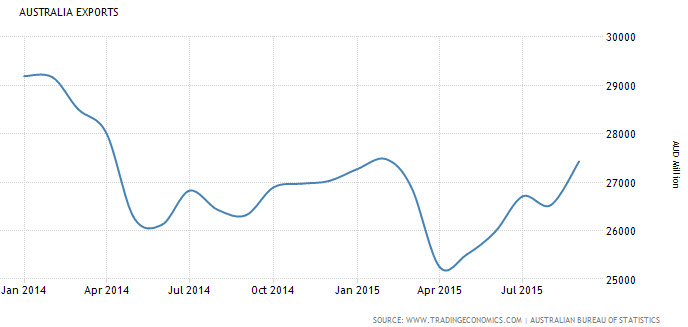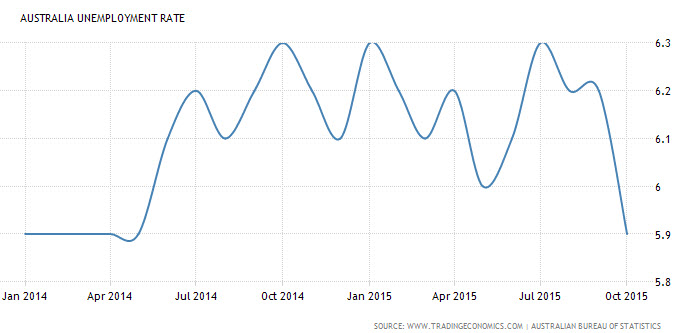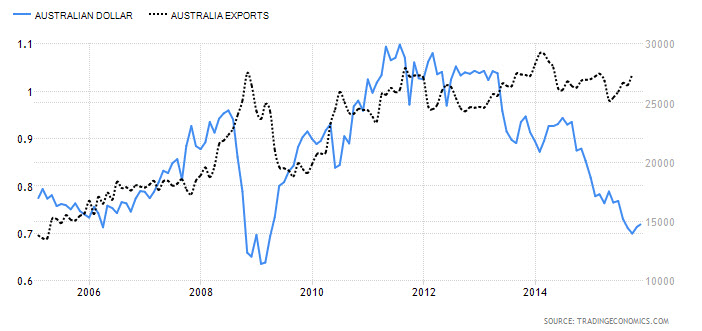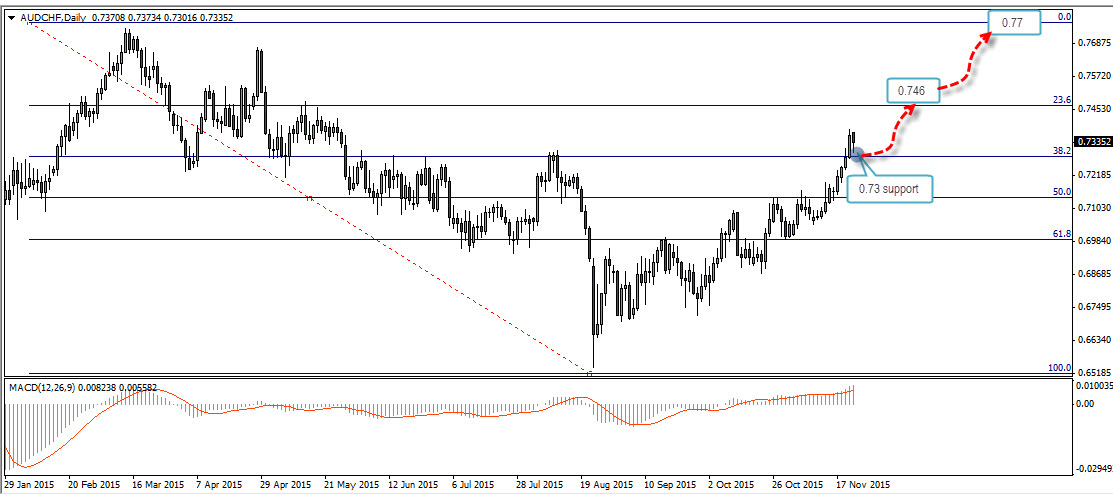
Two weeks ago investors in the Aussie Dollar were on the receiving end of a sweet surprise. The official unemployment rate dropped to 5.9%, smashing analysts’ expectations. That suggested the Reserve Bank of Australia’s latest easing cycle, which began about a year ago, might soon be ending.
But before you jump on the Aussie bandwagon, you need the right strategy.
Aussie Outlook Looking Brighter
The truth is that the whiff of optimism had been long overdue for the Aussie Dollar. Even before the unemployment data there had been tentative signs of stabilization in the Australian economy.
Key Points Of Improvement
Exports: Have been bouncing back. As the chart below indicates, Australia’s exporting position is strengthening. With Exports being the main driver of growth in Australia, this is rather important.

Chart courtesy of tradingeconomics.com
Inflation is stabilizing: Unlike the US or the UK, Australia’s headline inflation is already at a healthy pace of 1.5% YoY.
Unemployment: Last but not least, Australia’s official unemployment rate plunged abruptly from 6.2% in September to 5.9% in October. For the unemployment rate to shed 0.3% over a single month hiring has to be exceptionally strong.

Chart courtesy of tradingeconomics.com
Now, The Bad News
At first glance, any economic improvements in Australia might seem puzzling. After all, China, Australia’s main export destination, still looks weak. Commodities, Australia’s main export, are deep in bearish territory. How, then, with Australia’s growth pillar’s softening, can the Aussie recover? Quite simply—through the weak Australian Dollar.
While China’s economy softened and commodities plunged the Aussie Dollar plunged more than 20% vs. the US Dollar. This means that Australia’s strength is a classic case of a devalued currency. Rather than growth momentum driven by a stronger economic environment, the Aussie’s sharp fall has provided that respite.
Let’s look back at the exports picture since August 2014. If we neutralize the 23% plunge in the AUDUSD rate, a clearer picture emerges. While nominal exports have grown since the summer of 2014, currency-adjusted exports have plunged.
This also explains the stabilizing inflation numbers; as the Aussie weakened, imported goods began costing more and consumer prices moved higher.
What this means is that the recent strength of the Australian economy hangs upon a weaker Aussie Dollar. Consequently, if the Aussie strengthens, those positive factors will fade, and the outlook would dim once again.

Chart courtesy of tradingeconomics.com
Carving Your Aussie Strategy
From the preceding it might seem the average trader wouldn’t have any taste for an Aussie long. In fact, that shouldn’t be the case at all. True, if the macroeconomic environment stays as is, a stronger Aussie could derail the recovery. That would backfire on the Aussie Dollar. From a macroeconomic standpoint, the effect on a currency could take a while. Perhaps even a quarter or longer before it drills down to the real economy.
In the meanwhile, that leaves the RBA with no appetite for cutting rates. And that is enough to diverge, over the short term, from most central banks. Well, except, of course, from the Fed.
So how would we carve a strategy out of this? First, we need a pair with the Aussie and one side and, on the other, a currency with a loose monetary policy. Second, we know a stronger Aussie might backfire in the long term so we must focus on a short term trade.
Below, we have the daily chart for the AUDCHF pair. As you know, the CHF (Swiss Franc) moves in tandem with the Euro. Of course, stimulus is looming large on the Euro. That makes the AUDCHF a good place to start. (The reason we did not use the Euro is simply a matter of convenience. The chart pattern for the AUDCHF is more convenient for drawing a trajectory.)
As can be seen, the support lays around the Fibonacci level of 0.73. Meanwhile, the two resistance levels above are the two immediate targets. The pair could move towards the targets as ECB stimulus nears.
Those who prefer to avoid the Swissy (after the SNB fiasco back in January) have a viable alternative. The AUDJPY pair, especially with Japan’s economy slowing again, could also be a good fit.

Chart courtesy of Metaquotes
Look for my post next week.
Best,
Lior Alkalay
INO.com Contributor - Forex
Disclosure: This article is the opinion of the contributor themselves. The above is a matter of opinion provided for general information purposes only and is not intended as investment advice. This contributor is not receiving compensation (other than from INO.com) for their opinion.

I agree with your analysis. AUD USD has been in a several hundred pip range above .7000 for months now. I see a move below .7000 several hundred pips followed by a period of accumulation and then finally a strong move back up. The markets have been rangey lately. As all of the positive Aussie news and negative China news is absorbed by the market and the pair tests the top and bottom of the range above .7000, traders continue to take long positions against what appears to be selling pressure (professional accumulation). I think the market is going to continue to move down in a grinding fashion and the longs are going to continue to get stopped out. When price action gets below .7000 and everyone gets short the market will move higher.
good work. right direction. thanks
Great article, thank you!